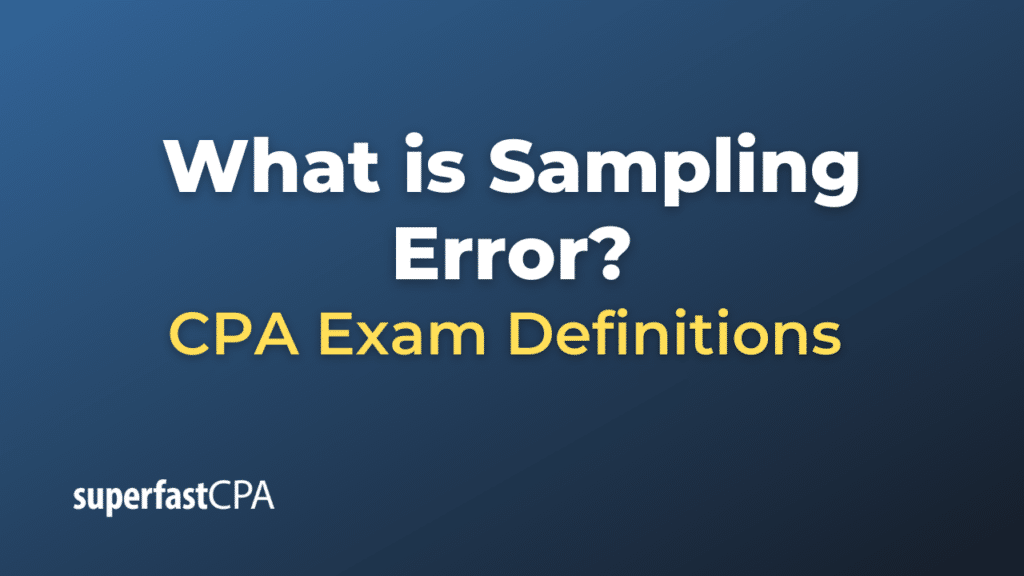Sampling Error
Sampling error refers to the discrepancy between a statistic derived from a sample and the true population parameter. In other words, it’s the error that arises due to the fact that a sample, rather than the entire population, is used to gather information.
To give a concrete example, let’s say you wanted to determine the average height of all adult men in a particular city, which has a million adult men. It would be impractical (if not impossible) to measure the height of every single man. Instead, you might randomly select 1,000 men and measure their heights. The average height of these 1,000 men is likely to be close to the average height of all million men, but it won’t be exactly the same. This difference between the sample average and the true population average is due to the sampling error.
It’s essential to understand a few things about sampling error:
- Randomness: Because samples are often selected randomly, there will always be some level of sampling error. Even if you drew multiple samples and calculated the same statistic (like an average), each sample would likely produce slightly different results.
- Size Matters: Generally, as the sample size increases, the sampling error decreases. If you sampled 10,000 men from the city rather than 1,000, your estimate would likely be closer to the true average. However, increasing sample size often comes with increased costs, so researchers often need to balance the precision of their estimates against the resources they have available.
- Not the Only Error: Sampling error is just one type of error that can occur in the research process. There are other potential errors, such as measurement errors or non-sampling errors (like bias introduced by non-response or faulty survey questions).
It’s worth noting that while all samples will have some sampling error, this doesn’t mean that sample estimates are useless. With the right sampling techniques and statistical procedures, researchers can still make accurate and valuable inferences about populations based on sample data. They can also use statistical methods to estimate the size of the sampling error and express their level of confidence in the sample’s results.
Example of Sampling Error
Let’s use a real-world example involving the election polling that is commonly done in various countries.
Scenario: Election Polling
Imagine there’s an upcoming presidential election in a country, and two main candidates are running: Candidate A and Candidate B.
Goal: You want to know which candidate is more popular and hence more likely to win the election.
Procedure: Instead of asking every eligible voter in the country (which would be millions of people and impractical to survey), you decide to take a random sample of 1,000 voters and ask them whom they plan to vote for.
Results: After conducting the survey, you find that 520 people (or 52%) say they will vote for Candidate A, while 480 people (or 48%) say they will vote for Candidate B.
Sampling Error: Now, just because your sample indicated that 52% favor Candidate A, this doesn’t mean exactly 52% of the entire voting population feels the same way. Your estimate based on the sample might be off by a few percentage points because of the sampling error.
Let’s say the actual percentage of voters in the entire country who favor Candidate A is 50%. Your sample overestimated this by 2%. That 2% discrepancy is the sampling error.
Further Considerations:
- Margin of Error: Pollsters will often report a “margin of error” along with polling results. For instance, they might say that Candidate A has 52% of the vote “plus or minus 3%.” This means the actual proportion of voters who favor Candidate A could be anywhere from 49% to 55%. This margin represents the range within which the true population parameter likely falls, given the sampling error.
- Confidence Level: Along with the margin of error, pollsters might specify a confidence level, e.g., “we are 95% confident.” This means that if the poll were conducted 100 times, in 95 out of those 100 samples, the result would fall within the stated margin of error.
- Non-Sampling Errors: If some groups of voters are less likely to respond to polls, or if there was a misunderstanding in how a question was phrased, the results could be biased. These are examples of non-sampling errors, and they can affect the accuracy of the poll results beyond just the inherent sampling error.
In summary, while sampling can provide a good estimate of the population’s preferences, it’s essential to consider the potential sampling error and other biases that could influence the results.













